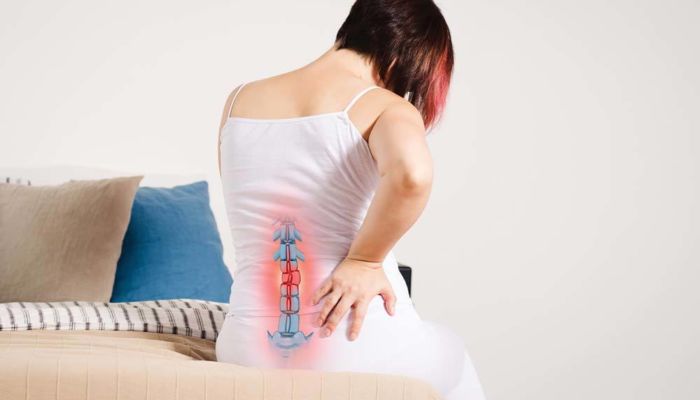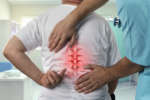Having tailbone pain can be a real pain in the - well, it can really hurt if it appears suddenly. The tailbone is relatively small compared to the rest of the spine, but if it hurts or aches, it’s incredibly noticeable. Like other back pain symptoms, patients may tend to overlook tailbone pain until symptoms worsen. Read on to learn more about tailbone pain, what causes it, what you should do when your tailbone hurts, and what treatments are available.
More About Tailbone Pain
The medical term for tailbone pain, especially the persistent type, is coccydynia. This is because the medical term for your tailbone is your coccyx, a term you’re probably at least slightly familiar with. The coccyx sits at the very bottom of the spine and, even though it is small, holds a few important jobs. Most importantly, the coccyx supports the pelvis. It also provides you stability as you sit or stand. Within and beside the coccyx are many supporting muscles, tendons, and ligaments, which can be irritated and inflamed.
Patients may first feel coccydynia when they attempt to stand or sit, or when you lean back in your chair while sitting. Women may also notice tailbone pain when they are menstruating, and both sexes can feel pain during sex or when using the bathroom. Standing is reported to relieve pressure, which helps the pain go away. Pain can also be felt in the length of the legs, such as a shooting pain.
Why Does My Tailbone Hurt?
Temporary tailbone pain can be caused by sitting on an uncomfortable seat, such as a hard bench or pew, for several hours. Trauma, such as falls and accidents, can also cause tailbone pain or cause the coccyx to break and fracture.
Tailbone pain can also be accompanied by age. Simple wear and tear can cause tailbone pain, or by repeating repetitive motions over and over. Pregnant women are also five times more likely to experience tailbone pain, as the ligaments in and near the coccyx begin to loosen in preparation for birth. This happens mainly during the third trimester.
Being overweight or obese is one of the biggest factors that may contribute to tailbone pain because of the amount of extra pressure being put on the coccyx. However, rapid weight loss is not healthy either. This is because the padding that protects the tailbone can be exposed, which makes the area much more prone to injury temporarily.
What Symptoms and Signs May Accompany Tailbone Pain?
One of the most significant noticeable signs that accompanies tailbone pain is pain when sitting or getting up from a sitting position. However, other signs may accompany tailbone pain that you should make your healthcare provider aware of. Let your doctor know if you:
- Have bruising around the coccyx area (this could be a sign of traumatic injury)
- Have deep, severe pain in the tailbone area that is localized
- The tailbone hurts when touched
- If the pain is worse after you’ve been sitting for long periods
- Bowel movements are painful
Being aware and informing your physician of multiple symptoms can aid in diagnosis as well as treatment.
What Should I Do if My Tailbone Hurts?
Most cases of tailbone pain are not serious, and the pain simply goes away in a few days. Commonly, tailbone pain occurs as a result of mild trauma, such as slipping on a patch of ice, falling down, or a minor motor vehicle collision. However, if the pain is excruciating or persists for more than several days, you should let your healthcare provider know. It is rare, but tailbone pain can be a sign of certain cancers, so if your pain is recurrent or persistent, be sure to see a healthcare provider. Pain may also be the result of a fracture or tumor, so it’s best to be checked just in case.
At your doctor’s appointment, your healthcare provider may perform a quick physical exam to check for growths around the area. He or she may also order imaging diagnostics, such as a CT scan or MRI, to see possible fractures or other problems. You’ll likely have to sit and stand in different positions so that the imaging can get multiple views of the tailbone.
How Can I Relieve It?
There are several options for treatment of coccyx pain. The most common treatment is nonsteroidal anti-inflammatory drugs (NSAIDs) for pain relief, such as ibuprofen. In many cases, patients can take over-the-counter NSAIDs for pain, although your doctor may prescribe prescription-strength NSAIDs or other types of pain relievers, based on your individual case.
Your doctor may also advise you to use stool softeners to relieve any type of constipation, as this can prevent strain, which can exacerbate tailbone pain. Injections are also a common treatment for coccyx pain. Your physician may inject corticosteroids or anesthetics into the area for pain relief. If you have an infected tailbone, then you need antibiotics.
Physical therapy is also a common prescription for tailbone pain, particularly stretching exercises. Your physical therapist will educate you on how to perform pelvic floor exercises as well as exercises to strengthen the stomach muscles.
In more severe cases, more intervention is needed. If tailbone pain is caused by a pilonidal cyst, your physician will need to make an incision and drain the cyst. If the coccyx is out of alignment, a quick procedure(coccygeal manipulation) may be required to return it back to its correct position.
A coccygectomy is the complete removal of the coccyx and is an option when all other avenues of treatment have been exhausted. This surgery does carry some risks, as the surgical site is an area that does not typically heal well, and infection is common. Also, a coccygectomy does not always ease the pain for the long-term.
Can I Prevent Tailbone Pain?
If you have recurrent tailbone pain, but it is not painful enough to see a physician, there are some things you can do at home to help prevent tailbone pain before it starts. It’s a good rule of thumb to avoid sitting on hard surfaces for long periods. If you must, get a shock-absorbent chair pillow or cushion. A “doughnut” cushion is a popular type that thwarts tailbone pain.
If you’ve fallen on ice or have had another traumatic injury, apply ice to the affected area for 15 to 20 minutes to help prevent swelling and pain.
If you suffer from constipation and strain during bowel movements, use stool softeners, and eat foods high in fiber to help regulate your system. This includes whole grains, beans and legumes, and apples. If you need more information about tailbone pain or need to be seen by a physician, request an appointment at NewSouth NeuroSpine. We have physicians, specialists, surgeons, and physical therapists on staff to meet all of your spinal and back pain needs in one office.






